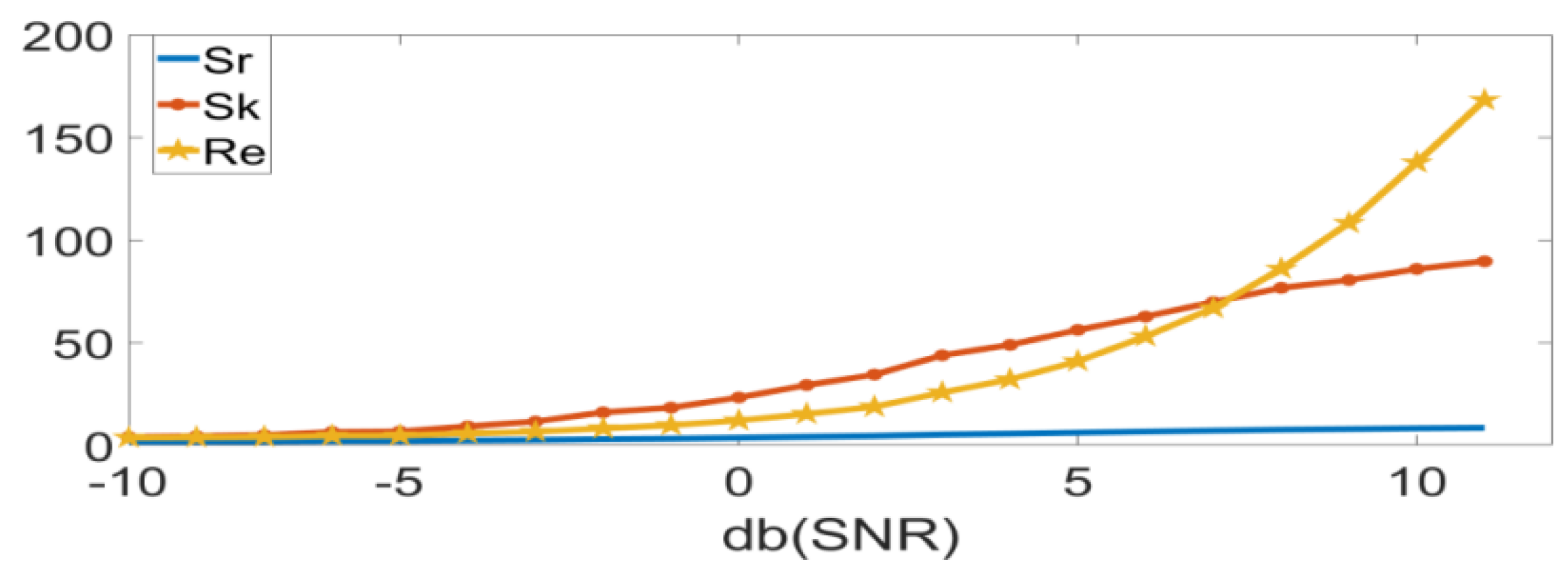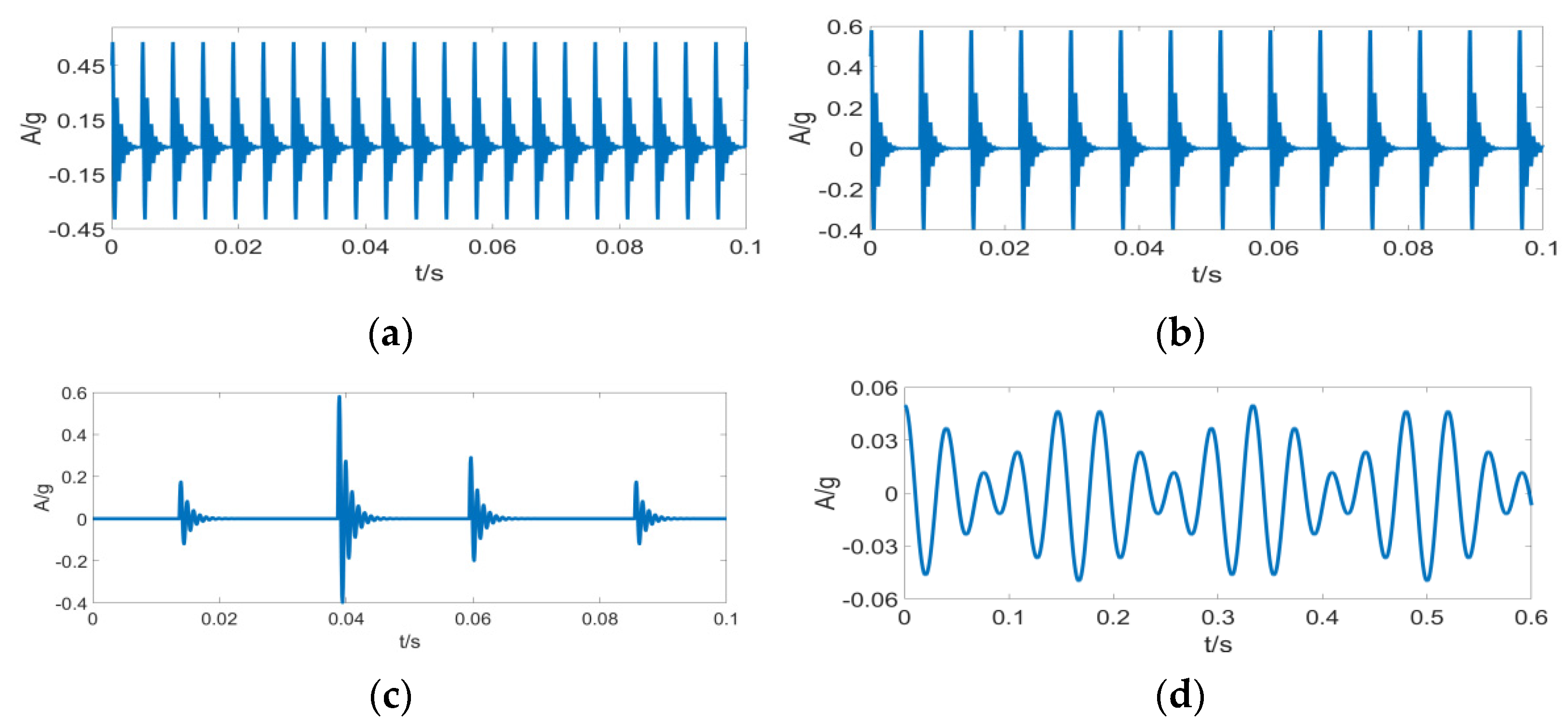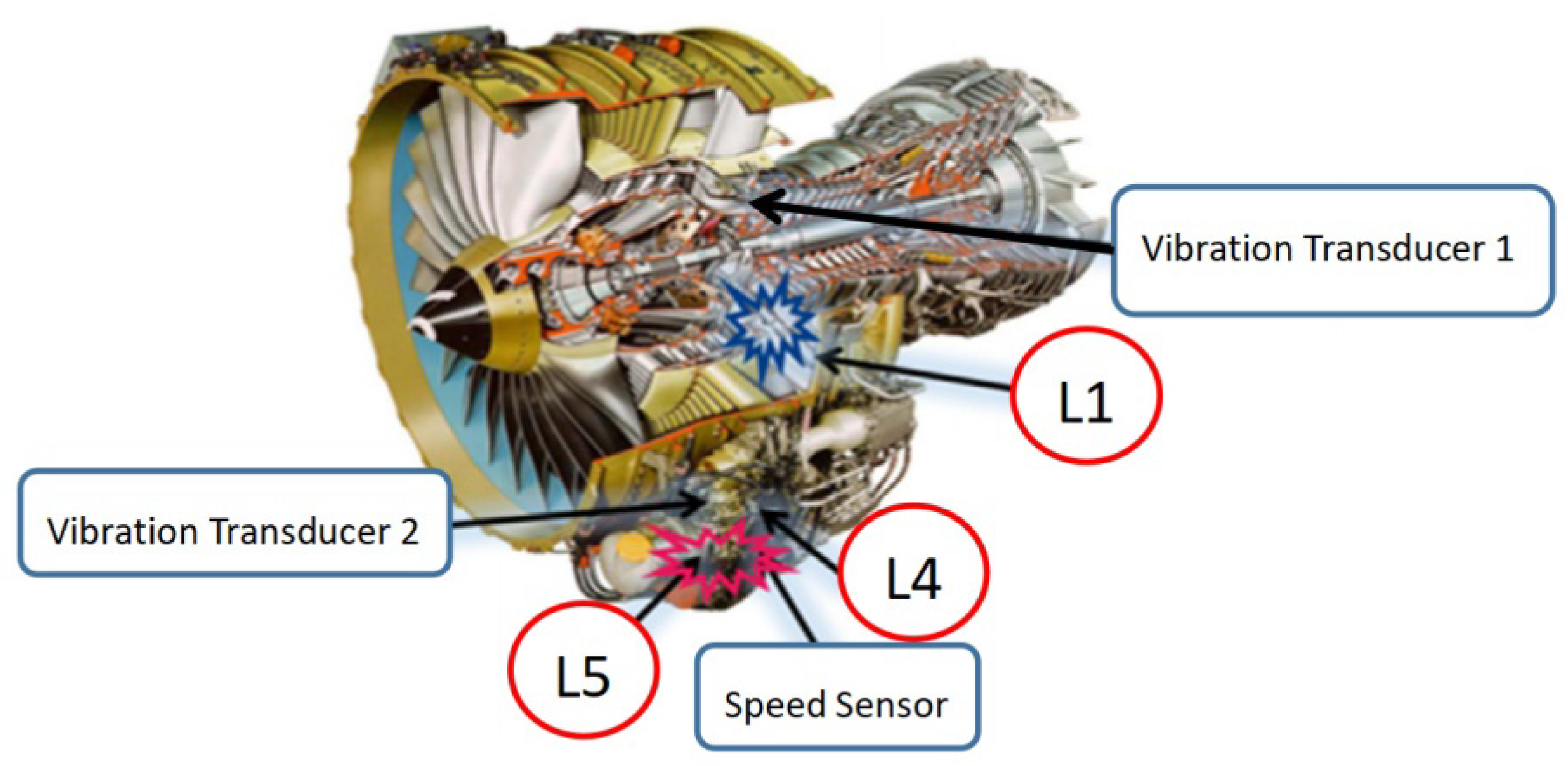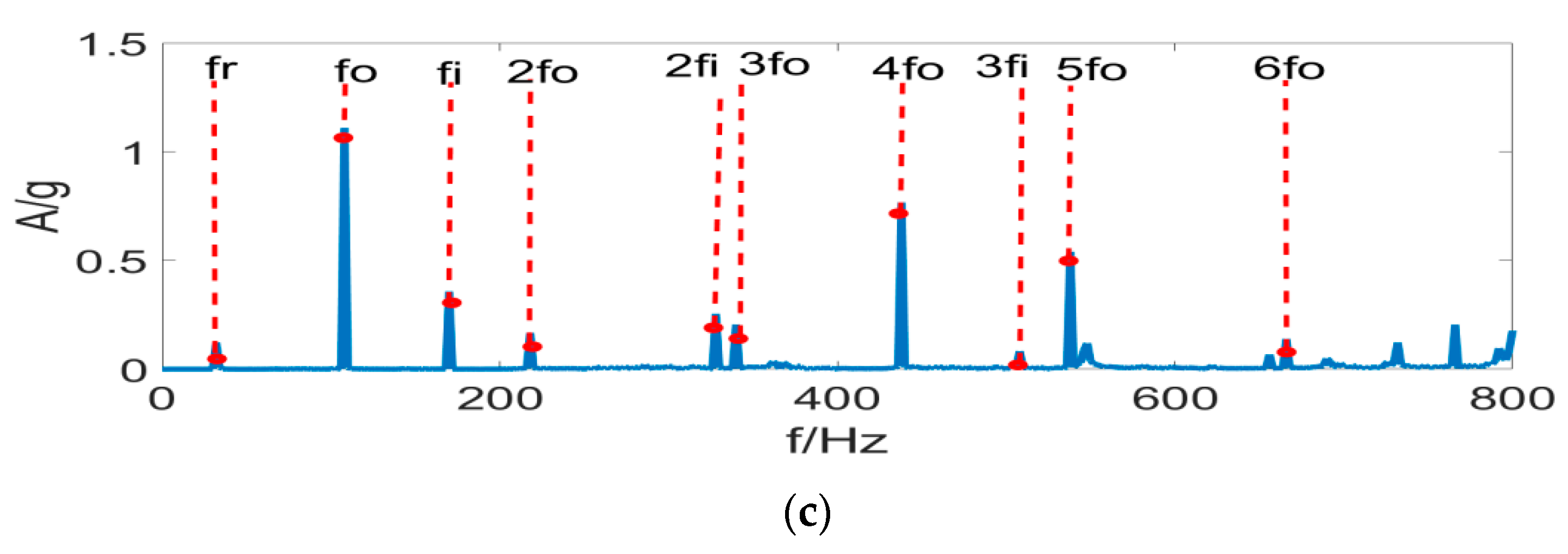Fault Feature-Extraction Method of Aviation Bearing Based on Maximum Correlation Re’nyi Entropy and Phase-Space Reconstruction Technology
Abstract
1. Introduction
2. Materials and Methods
2.1. Re’nyi Entropy (Re)
2.2. Correlation Re’nyi Entropy (CRe)
2.3. Maximum Correlation Re’nyi Entropy Deconvolution (MCReD)
2.4. Phase-Space Reconstruction(PSR)
2.5. Determination of Screening Space
- Phase-space trajectory matrix Xr is subjected to SVD.
- Ai values of various orders are derived separately, and the anti-diagonal method is used to reconstruct the sub-signals of various orders for Ai.
- is calculated and arranged in descending order as [Rei1, Rei2, …, Reij], Rei1 ≥ Rei2 ≥ … ≥ Reij > 0.
- By adopting the difference method Dj−1 = Reij − Reij−1 and solving max(Dj−1), the number of elements in the P space is determined to be j − 1.
- Screening space P is obtained based on the i mapped by Seij.
3. PSR–MCReD-Based Fault-Diagnosis Method
- Fault signal is input.
- is calculated according to the screening space selection method for PSR.
- Filter length is assumed as L, and to prevent the filter from falling into local optimal solution, the initial filter is assumed to be .
- , the filtered signal is calculated.
- and are calculated according to Formula (14).
- Filter is updated according to Formula (19).
- If is determined to be true, step 4 is returned to; if false, the process is ended. To avoid the iteration falling into an infinite loop, the ε in the formula is chosen as a tiny positive number.
- Final filter order result is calculated by formula .
- Envelope spectrum analysis is performed, and fault information is obtained.
4. Results
4.1. Simulation Analysis
4.2. Aeroengine Fault-Diagnosis
4.3. Validation of Composite-Fault Experimental Data
4.4. Experimental Verification
5. Conclusions
- In this study, a novel method for extracting the fault-signal features of aeroengine core components based on maximum CRe deconvolution integrating PSR is proposed. Through simulation analysis, experimental data, and a bench test, the advantages of the proposed method over the existing signal feature-extraction methods are verified regarding the extraction of complex fault-signal features under low SNR and complex noise interference.
- The mathematical formulas for Sk, Sr, and the narrow-sense Re proposed in this study are deduced based on the generalized Re. The three performance indicators can all be regarded as different expressions for generalized Re. As revealed by a simulation experiment on the correlations of the three with fault sensitivity and sporadic noise stability, both Re and Sk are highly sensitive to the faults, and Re is more stable to sporadic noise.
- Inspired by CK, a definition of CRe is given, which has a better suppression effect on the sporadic and harmonic noises. By deriving the solution formula of MCReD, a non-iterative method for solving the MCReD of the optimal filter is proposed.
- For the impulse signals with different periods under composite-fault conditions, a maximum Re-based subspace-filtering method is proposed by integrating the PSR technique into the MCReD calculation, which utilizes the noise-suppression and decomposition characteristics of SVD.
- Through simulation, experimental data validation, and bench test verification, the method proposed herein is proven to be fairly effective at extracting composite-fault signal features under low SNR and complex noise conditions.
Author Contributions
Funding
Institutional Review Board Statement
Informed Consent Statement
Data Availability Statement
Conflicts of Interest
Nomenclature
| Abbreviation | Implication |
| Sk | Kurtosis |
| Fk | Fast kurtogram |
| FIR | Finite impulse response |
| MED | Minimum entropy deconvolution |
| OMED | Optimal minimum entropy deconvolution |
| MCKD | Maximum correlated kurtosis deconvolution |
| MOMEDA | Multipoint optimal minimum entropy deconvolution adjustment |
| PSR | Phase-space reconstruction |
| SVD | Singular-value decomposition |
| Re | Re’nyi entropy, |
| Sr | Skewness |
| CRe | Correlation Re’nyi entropy |
| CSk | Correlation Kurtosis |
| MCReD | Maximum correlation Re’nyi entropy deconvolution |
| SNR | Signal-to-noise ratio |
References
- Ma, J.; Han, S.; Li, C.; Zhan, L.; Zhang, G.-Z. A New Method Based on Time-Varying Filtering Intrinsic Time-Scale Decomposition and General Refined Composite Multiscale Sample Entropy for Rolling-Bearing Feature Extraction. Entropy 2021, 23, 451. [Google Scholar] [CrossRef] [PubMed]
- Zhao, Q.; McDonald, G.L. Multipoint Optimal Minimum Entropy Deconvolution and Convolution Fix: Application to vibration fault detection. Mech. Syst. Signal Process. 2017, 82, 461–477. [Google Scholar]
- Zhang, X.; Miao, Q.; Zhang, H.; Wang, L. A parameter-adaptive VMD method based on grasshopper optimization algorithm to analyze vibration signals from rotating machinery. Mech. Syst. Signal Process. 2018, 108, 58–72. [Google Scholar] [CrossRef]
- Qin, Y.; Jin, L.; Zhang, A.; He, B. Rolling Bearing Fault Diagnosis with Adaptive Harmonic Kurtosis and Improved Bat Algorithm. IEEE Trans. Instrum. Meas. 2021, 70, 3508112. [Google Scholar] [CrossRef]
- Barszcz, T.; Randall, R.B. Application of spectral kurtosis for detection of a tooth crack in the planetary gear of a wind turbine. Mech. Syst. Signal Process. 2009, 23, 1352–1365. [Google Scholar] [CrossRef]
- Dong, X.; Lian, J.; Wang, H. Vibration source identification of offshore wind turbine structure based on optimized spectral kurtosis and ensemble empirical mode decomposition. Ocean Eng. 2019, 172, 199–212. [Google Scholar] [CrossRef]
- Wang, T.; Chu, F.; Han, Q.; Kong, Y. Compound faults detection in gearbox via meshing resonance and spectral kurtosis methods. J. Sound Vib. 2017, 392, 367–381. [Google Scholar] [CrossRef]
- Smith, W.A.; Fan, Z.; Peng, Z.; Li, H.; Randall, R.B. Optimised Spectral Kurtosis for bearing diagnostics under electromagnetic interference. Mech. Syst. Signal Process. 2016, 371–394. [Google Scholar] [CrossRef]
- Xiang, J.; Zhong, Y.; Gao, H. Rolling element bearing fault detection using PPCA and spectral kurtosis. Measurement 2015, 75, 180–191. [Google Scholar] [CrossRef]
- Antoni, J. Fast computation of the kurtogram for the detection of transient faults. Mech. Syst. Signal Process. 2007, 21, 108–124. [Google Scholar] [CrossRef]
- Lee, J.H.; Kim, D.H.; Shin, Y.H. Hyperbolic localization of incipient tip vortex cavitation in marine propeller using spectral kurtosis. Mech. Syst. Signal Process. 2018, 110, 442–457. [Google Scholar] [CrossRef]
- Wang, Y.; Ming, L. An adaptive SK technique and its application for fault detection of rolling element bearings. Mech. Syst. Signal Process. 2011, 25, 1750–1764. [Google Scholar] [CrossRef]
- Zhang, K.; Chen, P.; Yang, M.; Song, L.; Xu, Y. The Harmogram: A periodic impulses detection method and its application in bearing fault diagnosis. Mech. Syst. Signal Process. 2022, 165, 108374. [Google Scholar] [CrossRef]
- Baraniuk, R.G.; Flandrin, P.; Janssen, A.J.; Michel, O.J. Measuring time-frequency information content using the Renyi entropies. IEEE Trans. Inf. Theory 2001, 47, 1391–1409. [Google Scholar] [CrossRef]
- Boškoski, P.; Juričić, Đ. Fault detection of mechanical drives under variable operating conditions based on wavelet packet Rényi entropy signatures. Mech. Syst. Signal Process. 2012, 31, 369–381. [Google Scholar] [CrossRef]
- Boškoski, P.; Gašperin, M.; Petelin, D.; Juričić, Đ. Bearing fault prognostics using Rényi entropy based features and Gaussian process models. Mech. Syst. Signal Process. 2015, 52–53, 327–337. [Google Scholar] [CrossRef]
- Tao, B.; Zhu, L.; Han, D. An alternative time-domain index for condition monitoring of rolling element bearings—A comparison study. Reliab. Eng. Syst. Saf. 2007, 92, 660–670. [Google Scholar] [CrossRef]
- Antoni, J. The infogram: Entropic evidence of the signature of repetitive transients. Mech. Syst. Signal Process. 2016, 74, 73–94. [Google Scholar] [CrossRef]
- Wiggins, R.A. Minimum entropy deconvolution. Geophys. Prospect. Pet. 1980, 16, 21–35. [Google Scholar] [CrossRef]
- Endo, H.; Randall, R.B. Enhancement of autoregressive model based gear tooth fault detection technique by the use of minimum entropy deconvolution filter. Mech. Syst. Signal Process. 2007, 21, 906–919. [Google Scholar] [CrossRef]
- Yang, F.; Kou, Z.; Wu, J.; Li, T. Application of Mutual Information-Sample Entropy Based Med-IceemdanDe-Noising Scheme for Weak Fault Diagnosis of Hoist Bearing. Entropy 2018, 20. [Google Scholar]
- Cabrelli, C.A. Minimum entropy deconvolution and simplicity: A noniterative algorithm. Geophysics 2012, 50, 394–413. [Google Scholar] [CrossRef]
- Mcdonald, G.L.; Zhao, Q.; Zuo, M.J. Maximum correlated Kurtosis deconvolution and application on gear tooth chip fault detection. Mech. Syst. Signal Process. 2012, 33, 237–255. [Google Scholar] [CrossRef]
- Miao, Y.; Zhao, M.; Lin, J. Application of an im-proved maximum correlated kurtosis deconvolution method for fault diagnosis of rolling element bearings. Mech. Syst. Signal Process. 2017, 2, 173–195. [Google Scholar] [CrossRef]
- Guo, M.; Li, W.; Yang, Q.; Zhao, X.; Tang, Y. Amplitude filtering characteristics of singular value decomposition and its application to fault diagnosis of rotating machinery. Measurement 2020, 154, 107444. [Google Scholar] [CrossRef]
- Singh, J.; Darpe, A.K.; Singh, S.P. Bearing damage assessment using Jensen-Rényi Divergence based on EEMD. Mech. Syst. Signal Process. 2017, 87, 307–339. [Google Scholar] [CrossRef]
- Zhao, X.; Ye, B. Singular value decomposition packet and its application to extraction of weak fault feature. Mech. Syst. Signal Process. 2016, 70, 73–86. [Google Scholar] [CrossRef]
- Antoni, J.; Xin, G.; Hamzaoui, N. Fast computation of the spectral correlation. Mech. Syst. Signal Process. 2017, 92, 248–277. [Google Scholar] [CrossRef]
- Antoni, J.; Griffaton, J.; André, H.; Avendaño-Valencia, L.D.; Bonnardot, F.; Cardona-Morales, O.; Castellanos-Dominguez, G.; Daga, A.P.; Leclere, Q.; Vicuña, C.M.; et al. Feedback on the Surveillance 8 challenge: Vibration-based diagnosis of a Safran aircraft engine. Mech. Syst. Signal Process. 2017, 97, 112–144. [Google Scholar] [CrossRef]
- Wang, B.; Lei, Y.; Li, N.; Li, N. A Hybrid Prognostics Approach for Estimating Remaining Useful Life of Rolling Element Bearings. IEEE Trans. Reliab. 2018, 69, 401–412. [Google Scholar] [CrossRef]

















| M | g | ||||
|---|---|---|---|---|---|
| 50 | 0.7 | 1 | 0.7 | 10 | 2%T |
| Parameter | Implication | Value | Parameter | Implication | Value |
|---|---|---|---|---|---|
| 12,000 Hz | Amplitude of shock | Random variable | |||
| Random impact time | Random variable | ||||
| Harmonic amplitude | = 0.04 | ||||
| Harmonic frequency | |||||
| Initial phase |
| Rotating Frequency: fr | Rolling Element: fb | Outer Ring: fo | Inner Ring: fi | Cage: ft |
|---|---|---|---|---|
| 182.9 | 650.5 | 1419.5 | 1843.5 | 78.8 |
| Rotating Frequency: fr | Rolling Element: fb | Outer Ring: fo | Inner Ring: fi | Cage: ft |
|---|---|---|---|---|
| 45 | 89.6 | 137 | 222.7 | 17.01 |
Publisher’s Note: MDPI stays neutral with regard to jurisdictional claims in published maps and institutional affiliations. |
© 2022 by the authors. Licensee MDPI, Basel, Switzerland. This article is an open access article distributed under the terms and conditions of the Creative Commons Attribution (CC BY) license (https://creativecommons.org/licenses/by/4.0/).
Share and Cite
Zhang, Z.; Liu, B.; Liu, Y.; Zhang, H. Fault Feature-Extraction Method of Aviation Bearing Based on Maximum Correlation Re’nyi Entropy and Phase-Space Reconstruction Technology. Entropy 2022, 24, 1459. https://doi.org/10.3390/e24101459
Zhang Z, Liu B, Liu Y, Zhang H. Fault Feature-Extraction Method of Aviation Bearing Based on Maximum Correlation Re’nyi Entropy and Phase-Space Reconstruction Technology. Entropy. 2022; 24(10):1459. https://doi.org/10.3390/e24101459
Chicago/Turabian StyleZhang, Zhen, Baoguo Liu, Yanxu Liu, and Huiguang Zhang. 2022. "Fault Feature-Extraction Method of Aviation Bearing Based on Maximum Correlation Re’nyi Entropy and Phase-Space Reconstruction Technology" Entropy 24, no. 10: 1459. https://doi.org/10.3390/e24101459
APA StyleZhang, Z., Liu, B., Liu, Y., & Zhang, H. (2022). Fault Feature-Extraction Method of Aviation Bearing Based on Maximum Correlation Re’nyi Entropy and Phase-Space Reconstruction Technology. Entropy, 24(10), 1459. https://doi.org/10.3390/e24101459





